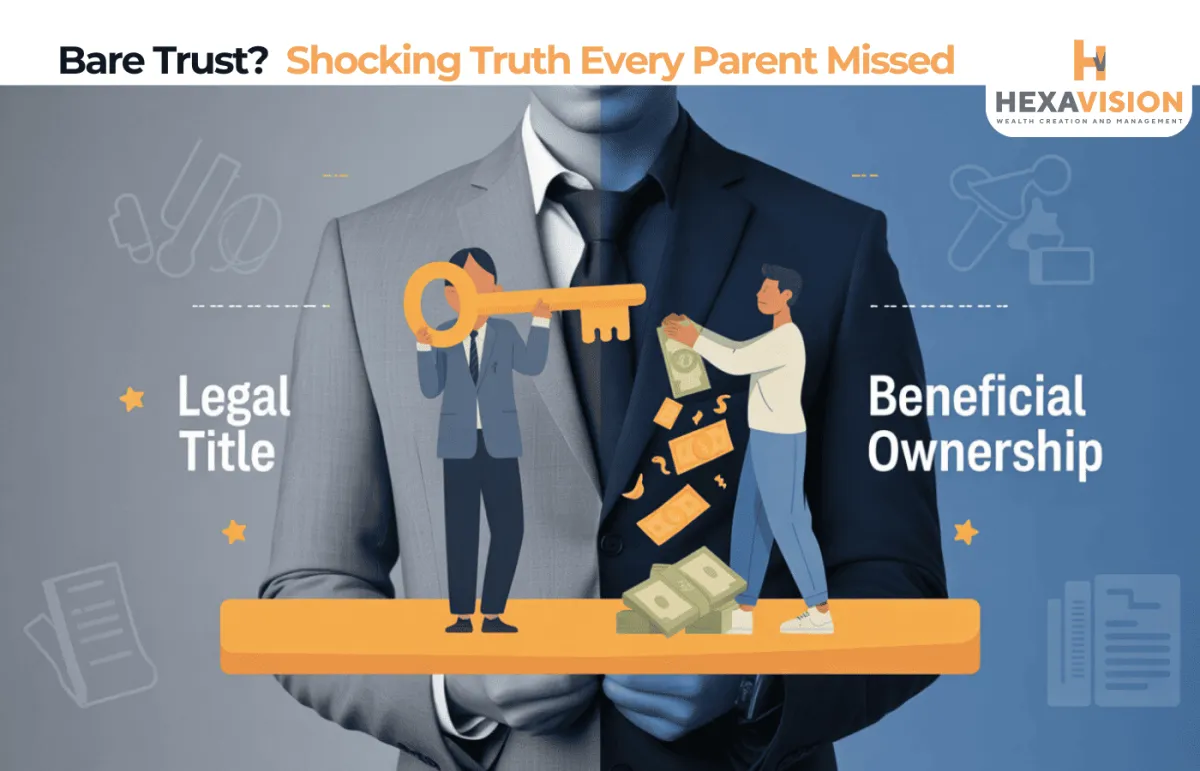
What Is a Bare Trust? Hidden CRA Rules Explained
Have you ever co-signed a mortgage for a family member? Or perhaps added a relative to the title of a property for estate planning purposes? If so, you might be surprised to learn you've likely entered the world of trusts—specifically, something called a bare trust. It’s one of the most common yet misunderstood legal arrangements in Canada. For years, these informal structures went under the radar, but recent tax reporting changes by the Canada Revenue Agency (CRA) have brought them into the spotlight, causing widespread confusion. This guide is here to clear up the confusion. We’ll explore the crucial question—what is a bare trust?—and break down what it means for your finances, your property, and your peace of mind.
This isn't just dry legal theory. Understanding this concept is critical, especially with the CRA’s shifting landscape. We'll cover real-world scenarios, the reporting rule changes (and the temporary relief), and what you absolutely need to know for 2025 and beyond.
So, Really, What is a Bare Trust?
At its core, a bare trust is the simplest form of trust you can have. Think of it like this: the trustee is merely a caretaker for your assets. They hold the legal title of an asset—whether it’s a house, a bank account, or an investment—but have no power to do anything with it unless the true owner, the beneficiary, gives them explicit instructions.
The term isn't even formally defined in Canada's Income Tax Act. Instead, the CRA describes it as an arrangement where the trustee is essentially an agent for the beneficiaries. They hold the legal deed, but the beneficiary holds all the important rights: the right to use, enjoy, and profit from the asset.
The Three Key Players: Trustee, Beneficiary, and Settlor
Every trust has a cast of characters. In a bare trust, their roles are straightforward:
The Trustee: This is the person or entity whose name is on the legal title of the asset. The trustee is simply a placeholder or nominee. They have no independent power, no discretion, and no active duties other than to follow the beneficiary's instructions. Their primary role is to hold the asset securely and transfer it when instructed.
The Beneficiary: The true owner of the asset. They have beneficial ownership. They enjoy all the benefits and carry all the risks. If the property generates rental income, it belongs to the beneficiary. If the property is sold for a profit, the capital gain is the beneficiary’s to report. The beneficiary has the right to demand the legal title be transferred to them at any time, provided they are of legal age and capacity.
The Settlor: The person who creates the trust by transferring the asset to the trustee. In many informal bare trust situations, the settlor and the beneficiary are the same person. For instance, if someone buys a property but places it in the name of a nominee corporation, they are both the settlor and the beneficiary.
Bare Trust vs. Nominee Arrangement: Is There a Difference?
You'll often hear the terms "bare trust," "nominee agreement," or "agency agreement" used interchangeably. For most practical purposes, especially from the CRA's perspective, they describe the same relationship: one party holding legal title as an agent for another. While lawyers might debate subtle distinctions, for the average Canadian, if an arrangement fits the description of a trustee acting solely on a beneficiary’s instructions, it's likely a bare trust.
Why Do People Use Bare Trusts? The Real-World Scenarios
Bare trusts are commonly used in various family, financial, and business situations. Here are a few examples of how they are used:
1. Real Estate and Bare Trusts
Real estate is the most common area where bare trusts are used. Here's a typical example:
Helping a Family Member Buy a Home: A parent co-signs the mortgage with their child or family member, and although the parent is on the title, the child is the sole beneficiary. This often creates a bare trust, though it may go unnoticed.
2. Estate Planning and Probate Avoidance
Adding a family member to the title of a property helps avoid probate fees. In such cases, a family member may hold legal title to the property to ensure a seamless transfer to the estate when the property owner passes away.
3. Privacy and Business Ventures
Bare trusts are also used to maintain privacy for the true owner of a property, especially in joint ventures or business transactions. Having a single nominee corporation on title simplifies the process and avoids listing multiple investors.
4. Planning for the Next Generation: Bare Trusts for Minors
Bare trusts are often used to hold assets for minors, where a parent or guardian acts as the trustee. This ensures the minor benefits from the assets once they reach the legal age.
5. In the Business World: Corporate and Investment Uses
Bare trusts can be used for corporate reorganization or to hold shares without changing the registered owner constantly, streamlining transactions and reducing administrative complexity.
The CRA and Bare Trust Reporting Rules

For decades, bare trusts were informal and had no filing obligations. All income was reported by the beneficiary, and the trust itself was ignored. However, this changed in recent years, creating confusion for many Canadians.
The Big Shake-Up: What Changed and Why?
As part of a global effort to increase financial transparency and curb tax avoidance, the Canadian government introduced new, enhanced trust reporting rules. Starting in 2023, most trusts—including bare trusts—were required to file an annual T3 Trust Income Tax and Information Return.
The new rules included completing a detailed Schedule 15, which demands personal details (name, address, date of birth, SIN) for every trustee, beneficiary, and settlor. The penalties for failing to file were steep, with fines starting at $2,500 and increasing significantly.
A Collective Sigh of Relief: The CRA's 2023 & 2024 Filing Exemption
In response to the confusion, the CRA offered temporary relief. Bare trusts were exempted from filing T3 returns and Schedule 15 for the 2023 and 2024 tax years, unless specifically requested by the CRA. This exemption has helped alleviate the immediate burden for many Canadians.
Looking Ahead: Understanding CRA Trust Filing Obligations 2025 and Beyond
The future of CRA bare trust reporting rules is still evolving. In August 2024, the Department of Finance released draft legislation to clarify the rules for the 2025 tax year and onward.
The proposal aims to exempt certain common bare trust arrangements from filing, such as when a family member is on title of a property for financing purposes. However, more complex arrangements may still be required to file, so it's essential to stay updated on the proposed changes.
Is CRA’s New Bare Trust Policy Causing More Harm Than Good?
The introduction of new bare trust reporting rules has sparked debate. On one hand, the goal of increased transparency is supported by many, as it aligns with international efforts to combat money laundering and ensure those benefiting from assets pay their fair share of taxes.
On the other hand, the rollout was criticized for poor communication, causing confusion and stress for taxpayers. The CRA’s initial vague guidance left many taxpayers scrambling, only to have the filing deadlines waived at the last minute, which undermined public trust in the agency.
The Nitty-Gritty: Legal and Tax Implications of Bare Trusts in Canada
Beyond the reporting requirements, it's essential to understand the legal and tax realities of bare trusts.
Who is the Trustee in a Bare Trust, and What Are Their Legal Responsibilities?
The trustee holds legal title to the asset but has no independent power over it. Their responsibility is to protect the asset and follow the beneficiary's instructions. A written Declaration of Trust is highly recommended to formalize the agreement and protect the interests of both parties.
Beneficiary Rights Under a Bare Trust: You're in the Driver's Seat
As the beneficiary, you hold full control over the asset. You can direct the trustee to sell the asset, transfer the legal title, or take any other action. The trustee is simply your agent and acts on your instructions.
Tax Implications of Bare Trusts in Canada: Who Pays?
For income tax purposes, the bare trust is disregarded. All income, such as rental income or interest, and capital gains from selling the asset flow directly to the beneficiary, who is responsible for reporting them on their personal tax return. The trustee does not report any income.
What is a Bare Trust? A Practical Checklist for Canadians
Still unsure if you're part of a bare trust? Here’s a checklist:
Is your name on the title of a property that you don't truly consider your own?
Do you have a joint bank or investment account with a family member where the funds are intended solely for their benefit?
Are you the sole director of a nominee corporation that just holds legal title to a piece of land for a group of investors?
Do you hold an "in-trust-for" (ITF) account for a minor?
If you answered "yes" to any of these, you may be involved in a bare trust arrangement. It’s essential to document the arrangement and stay updated on CRA announcements regarding filing requirements.
Conclusion: What is a Bare Trust?
A bare trust is a simple yet powerful legal tool that separates legal ownership from beneficial ownership. It allows for flexible estate planning, privacy, and simplified business transactions. While recent CRA reporting changes have added complexity, understanding the basics of a bare trust will help you navigate potential tax and legal challenges in the years ahead.
With this knowledge, you can now identify a bare trust, understand the roles of everyone involved, and be prepared for the evolving tax landscape. Consulting a tax or legal professional is essential to ensure your specific situation is handled correctly, providing clarity and confidence in your financial affairs.
Frequently Asked Questions (FAQ)
What is a bare trust in Canadian tax law? A bare trust is an arrangement where the trustee holds legal title to an asset but acts solely as an agent for the beneficiary, who retains ownership and tax obligations.
Do I need to report a bare trust to CRA in 2025? It depends on the nature of your bare trust. Some bare trust arrangements are exempt from filing, while others may still be required to file. Stay updated on CRA announcements.
What’s the difference between a nominee and a bare trust? A nominee is a person or company holding an asset on behalf of the real owner. This relationship is legally structured as a bare trust, where the nominee (the trustee) has no independent powers and acts solely on the instructions of the owner (the beneficiary).
How do bare trusts affect property ownership? A bare trust splits property ownership into two parts: legal title and beneficial ownership. The trustee holds the legal title, while the beneficiary holds the beneficial ownership, with all rights to use and profit from the property.
Who is liable for tax in a bare trust arrangement? The beneficiary is responsible for all taxes associated with the assets in a bare trust, including income and capital gains.
How should I document my bare trust arrangement? It’s advisable to create a written Declaration of Trust to formally document the arrangement and protect your interests in case of disputes or CRA audits.
